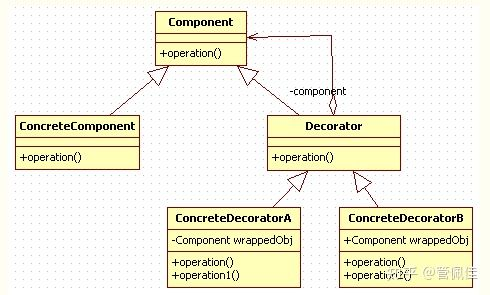装饰器 Decorator
允许向一个现有的对象添加新的功能,同时又不改变其结构。这种设计类型属于结构性模式,它是作为现有类的一个包装
这种设计模式创建了一个装饰类,用来包装原有的类,并在保持类方法签名完整的前提下,提供额外的功能。
意图:动态滴给一个对象添加一些额外的职责,就增加功能来说,装饰器相比于生成子类,更加灵活
何使使用装饰器: 在不想增加子类的情况下,扩展类
优点:装饰类和被装饰类可以独立发展,不会相互耦合,装饰模式是继承的一个替代模式,装饰模式可以动态扩展一个实现类的功能。
缺点:多层装饰比较复杂。
使用场景: 1、扩展一个类的功能。 2、动态增加功能,动态撤销。

//基础接口 public interface Component { public void biu(); } //具体实现类 public class ConcretComponent implements Component { public void biu() { System.out.println("biubiubiu"); } } //装饰类 public class Decorator implements Component { public Component component; public Decorator(Component component) { this.component = component; } public void biu() { this.component.biu(); } } //具体装饰类 public class ConcreteDecorator extends Decorator { public ConcreteDecorator(Component component) { super(component); } public void biu() { System.out.println("ready?go!"); this.component.biu(); } }
//使用装饰器 Component component = new ConcreteDecorator(new ConcretComponent()); component.biu(); //console: ready?go! biubiubiu